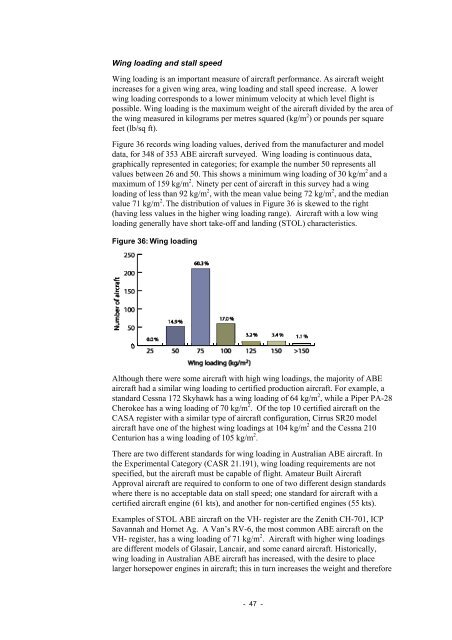Amateur-built and experimental aircraft - Australian Transport Safety ...
Amateur-built and experimental aircraft - Australian Transport Safety ...
Amateur-built and experimental aircraft - Australian Transport Safety ...
You also want an ePaper? Increase the reach of your titles
YUMPU automatically turns print PDFs into web optimized ePapers that Google loves.
Wing loading <strong>and</strong> stall speed<br />
Wing loading is an important measure of <strong>aircraft</strong> performance. As <strong>aircraft</strong> weight<br />
increases for a given wing area, wing loading <strong>and</strong> stall speed increase. A lower<br />
wing loading corresponds to a lower minimum velocity at which level flight is<br />
possible. Wing loading is the maximum weight of the <strong>aircraft</strong> divided by the area of<br />
the wing measured in kilograms per metres squared (kg/m 2 ) or pounds per square<br />
feet (lb/sq ft).<br />
Figure 36 records wing loading values, derived from the manufacturer <strong>and</strong> model<br />
data, for 348 of 353 ABE <strong>aircraft</strong> surveyed. Wing loading is continuous data,<br />
graphically represented in categories; for example the number 50 represents all<br />
values between 26 <strong>and</strong> 50. This shows a minimum wing loading of 30 kg/m 2 <strong>and</strong> a<br />
maximum of 159 kg/m 2 . Ninety per cent of <strong>aircraft</strong> in this survey had a wing<br />
loading of less than 92 kg/m 2 , with the mean value being 72 kg/m 2 , <strong>and</strong> the median<br />
value 71 kg/m 2 . The distribution of values in Figure 36 is skewed to the right<br />
(having less values in the higher wing loading range). Aircraft with a low wing<br />
loading generally have short take-off <strong>and</strong> l<strong>and</strong>ing (STOL) characteristics.<br />
Figure 36: Wing loading<br />
Although there were some <strong>aircraft</strong> with high wing loadings, the majority of ABE<br />
<strong>aircraft</strong> had a similar wing loading to certified production <strong>aircraft</strong>. For example, a<br />
st<strong>and</strong>ard Cessna 172 Skyhawk has a wing loading of 64 kg/m 2 , while a Piper PA-28<br />
Cherokee has a wing loading of 70 kg/m 2 . Of the top 10 certified <strong>aircraft</strong> on the<br />
CASA register with a similar type of <strong>aircraft</strong> configuration, Cirrus SR20 model<br />
<strong>aircraft</strong> have one of the highest wing loadings at 104 kg/m 2 <strong>and</strong> the Cessna 210<br />
Centurion has a wing loading of 105 kg/m 2 .<br />
There are two different st<strong>and</strong>ards for wing loading in <strong>Australian</strong> ABE <strong>aircraft</strong>. In<br />
the Experimental Category (CASR 21.191), wing loading requirements are not<br />
specified, but the <strong>aircraft</strong> must be capable of flight. <strong>Amateur</strong> Built Aircraft<br />
Approval <strong>aircraft</strong> are required to conform to one of two different design st<strong>and</strong>ards<br />
where there is no acceptable data on stall speed; one st<strong>and</strong>ard for <strong>aircraft</strong> with a<br />
certified <strong>aircraft</strong> engine (61 kts), <strong>and</strong> another for non-certified engines (55 kts).<br />
Examples of STOL ABE <strong>aircraft</strong> on the VH- register are the Zenith CH-701, ICP<br />
Savannah <strong>and</strong> Hornet Ag. A Van’s RV-6, the most common ABE <strong>aircraft</strong> on the<br />
VH- register, has a wing loading of 71 kg/m 2 . Aircraft with higher wing loadings<br />
are different models of Glasair, Lancair, <strong>and</strong> some canard <strong>aircraft</strong>. Historically,<br />
wing loading in <strong>Australian</strong> ABE <strong>aircraft</strong> has increased, with the desire to place<br />
larger horsepower engines in <strong>aircraft</strong>; this in turn increases the weight <strong>and</strong> therefore<br />
- 47 -

















